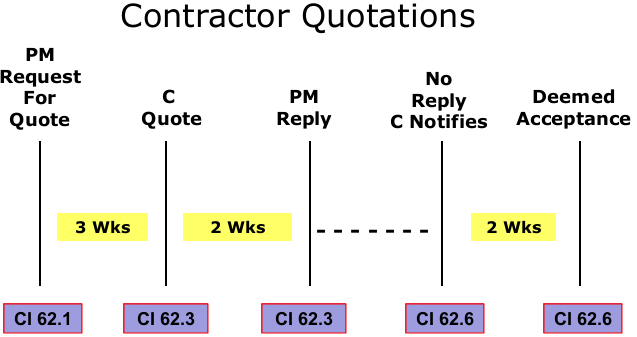Quotations for Compensation Events
-
As with the term “Compensation Event” (“CE”), the NEC does not set out a definition of what a quotation actually is (Rowlinson. 2011, p.180). From Clause 62.2 it can be seen that a quotation is a proposal from the Contractor for changes to the Prices and any delay to the Completion Date and Key Dates as assessed by the Contractor. The Contractor makes forecasts which will be at the Contractor’s risk. If the Contractor fails to supply a quotation, the Project Manager can make his own assessment, for four reasons as set out in Clause 64.1.
-
The following diagram shows the basic quotation process1:

-
It is the intention under NEC3 that the Contractor supplies a quotation and assesses the time and cost implications of a CE in accordance with Clause 62.2. The Contractor’s assessment involves producing a prospective estimate of the cost and/or time for the event.
Issues with Ce Quotations – What does the Literature say?
-
The literature on this subject shows that the quotation mechanism can be considered onerous and a failure by either party to keep to the timescales set by the NEC can raise all sorts of questions and issues.
-
When discussing the CE quotation regime, Ennis (2010) states it has its own complications in terms of notice, timing of submission of quotations and, as an extra complication, revised quotations with additional time provisions relating to these revised quotations and responses to the same by the Project Manager. Ennis (2010) also comments on the seemingly onerous term that deems acceptance of a quotation if there is an absent reply from the Project Manager within two weeks of expiry of the original time for response, upon notice2. On a busy project, the number of CE’s can be considerable and there is a tendency for them to pile up and be postponed (Bange, 2012). When CE’s are priced after the event has occurred, then the question arises whether the CE should be priced retrospectively based on known facts or prospectively. It is well known in the industry that NEC can place an onerous administrative burden on the parties (Bange, 2012). The NEC CE mechanism does not seem to contemplate that CE’s which should be priced prospectively before the event are often priced after the event.
-
Eggleston (2006) comments on the fairness of the CE procedure and states that by putting the risk of forecasting on the Contractor and by combining the valuation of changes with the valuation of the Employer’s breaches of contract (CE’s), there is considerable potential for the Contractor to lose money in circumstances where normally cost recovery would be regarded as a fair outcome.
-
Keating on NEC3 (Thomas, 2012) identifies issues with who pays for the cost of preparing quotations as it is different between the options. He also identifies inconsistency between the contract and guidance notes, with Clause 62.2 not requiring the Contractor to submit a revised programme but the guidance note for this clause stating a revised programme should be included.
-
Keating on NEC3 (Thomas, 2012, p.274) also identifies practical problems with the quotation process:
“On a complex project, this may lead to a backlog of compensation events all due for assessment at the same time….The time pressure presented by the ECC may also lead to a contractor presenting claims for delay and increased Prices on a global basis.”
-
On a busy project, the number of CE’s can be considerable and there is a tendency for them to pile up and be postponed (Bange, 2012).
Issues with Ce Quotations – What does my Research say?
-
The quotation for CE’s is the main element to the CE contract mechanism and should be fair to both parties, certain and operable. A number of principles surrounding the quotation process were researched as follows:
Time and Money
-
The intention of NEC3 is to combine both time and money but the research has shown that, when respondents were asked
“As a percentage rate, how often do you submit or see submitted Compensation Event quotations which include both time and money?”, only 3% said they were combined 100% of the time and only a further 27% said they were combined 75% of the time.
-
Further investigation into this issue through interviews shows people in the industry are happy with time and money being combined. An Employer’s view was:
“I’m quite happy – it’s quite workable and how else would you do it…” (Employer Interview)
-
When discussed with the Lawyer, he made the following comments:
“I just find the whole concept of agreeing issues like that within a limited timescale, time and money, particularly on projects where there is any degree of change, just becomes unworkable.” (Lawyer Interview)
-
Parties to the contract are happy for time and money to be combined but, in the main, do not actually deal with CE quotations in this way. This raises the question; why? From the interviews, the general reason was that it became an administrative burden, especially when lots of events occurred or lots of small events make it difficult to produce programmes for each event. It appears that once a Contractor or Project Manager fall behind with the process, the position is rarely recovered.
Proactive Basis
-
The research asked respondents, as a percentage, rate how often do you price or see CE’s priced in a proactive way. The research found that organisations do not price CE’s proactively 100% of the time and 79% of them priced proactively 50% of the time or less. This was confirmed when discussed in interviews, as can be seen in the quote from the Project Manager and Lawyer:
“In my experience most contractors and Project Managers fail dismally to proactively quote.” (Project Manager Interview)
“On a pro-active basis. Almost never.” (Lawyer Interview)
-
The qualitative research from the interviews backs up the quantitative research from the questionnaires that most CE’s are not priced on a proactive basis. When CE’s are priced after the works have occurred, then the question arises whether the CE should be priced retrospectively based on known facts or prospectively3.
Is it Onerous?
-
Respondents were asked to rate between 1 and 5 (with 5 being onerous), how onerous they believed that the CE process is for a Contractor and Sub-Contractor; 73% rated it 4 or 5 out of 5. This point was discussed in interviews and there were differing views with the Project Manager not seeing it as onerous whilst the Lawyer viewed it as “extremely onerous” (his view maybe tainted from his experience of only dealing with disputes). The general view from the interviews was that it became onerous when there were many CE’s and/or when there was a lack of resources available to produce quotations.
Who Carries the Risk?
-
The research also endeavoured to establish whether people thought the risk lay in the quotation process. It showed that 79% of respondents rated it 1 or 2 out of 5 in favour of the Contractor carrying the risk. When this point was raised in interviews, both the Contractor and Employer believed they carried the risk. However, the interviewed Adjudicator did raise the following valid point:
“It seems to me, therefore, that there is more risk with a Contractor, who is unlikely to know at the time of quoting for a major CE, the effect it will have on all the following Sub-Contractors and probably will not be able to get all the information in time for the submission of the quotation.”
Summary
-
NEC3 quotations should combine both time and money and this principle is understood, however, in reality it appears that this does not happen practically. There seems to be an underlying uncertainty and suspicion between the parties, with both Contractors and Employers believing that they carry the risk. The research shows it is generally agreed that the process is onerous for Contractors and Sub-Contractors. There is a suspicion about dealing with quotations on a prospective basis, with the Employer believing that the Contractor will overstate his resources in quotations and a mentality that this will be reduced by the Project Manager. Anecdotally, this could be said to be a “JCT mentality” or even industry mentality of confrontation rather than “mutual trust and co-operation”.
-
Failure to follow the contract by not combining time and money, as well as not pricing proactively on a prospective basis, leads to disputes over how the works should be valued, as one party seeks to price prospectively and the other retrospectively using actual resources. These uncertainties become exacerbated when there is a formal dispute.
Note: This article is based on the author's own research
Bibliography
-
Bange, V. 2012. A Necessary evil? Construction Law. 2012. 23(9).
-
Eggleston, B. 2006. The NEC3 Engineering and Construction Contract: A Commentary. Oxford: Blackwell Publishing.
-
Ennis, Christopher. 2010. Financial Claims under NEC3 Contracts: An Overview. A paper presented to the Society of Construction Law Annual Conference in Leeds on 5 March 2010.
-
Rowlinson, M. 2011. A Practical Guide to the NEC3 Engineering and Construction Contract. 1st Edition: London: Wiley-Blackwell.
-
Thomas, D. 2012. Keating on NEC3. 1st Edition. London: Sweet & Maxwell.
Footnotes
1. Note: Sub-contractor timescales are slightly different.
2. Clause 62.6
3. Anecdotally, this is commonly debated in Adjucations.
-
Sheffield
The Annexe,
260 Ecclesall Road South,
Ecclesall,
Sheffield,
S11 9PSTel - 0114 230 1329
-
London
Adam House,
7-10 Adam Street,
London,
WC2N 6AATel – 020 7520 9295
-
Leeds
Suite 69,
4100 Park Approach,
Thorpe Park,
Leeds,
LS15 8GBTel - 0113 397 0358
-
Warrington
Suite 41,
Lakeview 600,
Lakeside Drive,
Centre Park Square,
Warrington,
WA1 1RWTel - 01925 984705
-
Manchester
3 Hardman Street,
Manchester,
M3 3HFTel - 0114 230 1329
-
Birmingham
Birmingham Business Park,
4200 Waterside Centre,
Solihull Parkway,
Birmingham,
B37 7YNTel - 0121 481 2381
-
Liverpool
Horton House,
Exchange Flags,
Liverpool,
L2 3PFTel - 07753 837149
